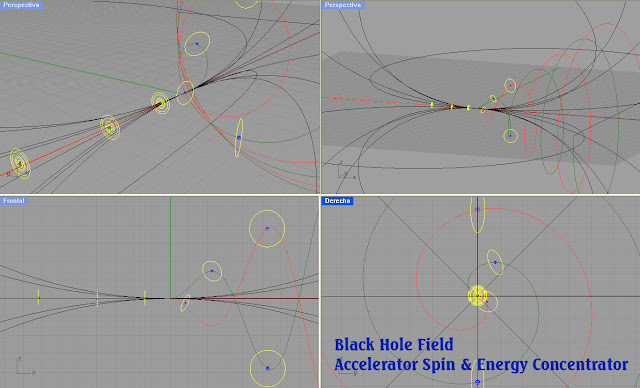Teoría sobre Agujeros Negros.
Los grandes superposicionadores de energía del universo.
La idea expresada en este breve texto acerca de como debe ser un agujero negro es fácil de comprender si se contempla desde la base de la Teoría Espacial de Campos, una idea que he ido madurando a lo largo de mis años a partir de dudas que me he ido encontrando tras el estudio de la versión generalizada. En un breve resumen, un agujero negro se definiría como una concentración de campo que tiene su origen a partir de una estructura con tendencia anular de masa como ocurren en las galaxias, con traslación de la misma y que tiende a encontrar su equilibrio en un plano estelar alrededor de su vórtice de campo polarizado.
La estructura polarizada de campo que se establece a partir de la superposición de todos los campos permitiría establecer un vórtice de campo estable que, ademas de dar solidez a la estructura, haría que todas las partículas que caigan en el experimenten una doble aceleración a la vez que se alinean con el eje dominante en la estructura, es decir, se aceleran en su caída a la vez que se aceleran en au espín. El resultado será una concentración de energía superpuesta en un mismo punto que lógicamente cambia en su escala de interacción con el universo al aumentar su densidad, pero reduciéndose el alcance de su campo "horizonte de influencia" a consecuencia de la aceleración que experimentan su espín y su relación con el límite "c".
Representación gráfica de un agujero negro formada a partir de la visión de campos.
Imagen visual de un agujero negro:
Si observásemos la radiación procedente de un agujero negro, deberíamos tener en cuenta la deriva del campo que experimenta este en nuestra galaxia a consecuencia del desplazamiento de la materia que lo origina y nuestro propio desplazamiento. Teniendo en cuenta ambos vectores, podremos re-interpretar la imagen obtenida y obtener una nueva imagen que nos verifique su naturaleza. Esta diferencia entre la imagen original y la percibida se debe a que debido a la gran distancia, no tenemos en cuenta la deriva que experimenta la luz en su viaje a través del campo de la galaxia.
En breve les mostraré una imagen:
Les dejo con tres publicaciones para entender y calcular la deriva del campo por desplazamiento circular de sus masas.
Superposition Energy concentrator through the acceleration of the spin.
The great energy super-potioners.
The idea expressed in this brief text about what a black hole should be like is easy to understand if it is viewed from the basis of the Spatial Field Theory, an idea that I have been maturing over the years based on doubts that I have encountered after studying the generalized version. In a brief summary, a black hole would be defined as a field concentration that has its origin from a structure with an annular mass tendency as occurs in galaxies, with its translation and that tends to find its equilibrium in a plane star around its polarized field vortex.
The polarized field structure that is established from the superposition of all the fields makes it possible to establish a stable field vortex that, in addition to giving solidity to the structure, causes all the particles that fall into it to experience a double acceleration at the same time that they align with the dominant axis in the structure, that is to say, they accelerate their fall at the same time as they accelerate their spin. The result will be a concentration of energy superimposed on a single point that logically changes in its scale of interaction with the universe as its density increases, but the scope of its "horizon of influence" field is reduced as a consequence of the acceleration experienced by its spin and its relation to the "c" limit.
Visual image of a black hole:
If we were to observe the radiation coming from a black hole, we would have to take into account the drift of the field that it experiences in our galaxy as a result of the displacement of the matter that originates it and our own displacement. Taking into account both vectors, we will be able to re-interpret the image obtained and obtain a new image that verifies its nature. This difference between the original image and the perceived one is due to the fact that due to the great distance, we do not take into account the drift that the light experiences in its journey through the field of the galaxy.
I will show you an image shortly:
I leave you with three publications to understand and calculate the field drift by circular displacement of its masses.

No hay comentarios:
Publicar un comentario